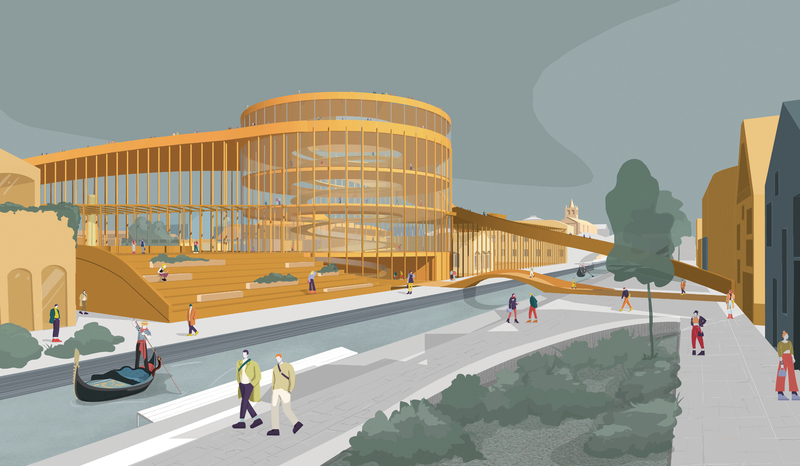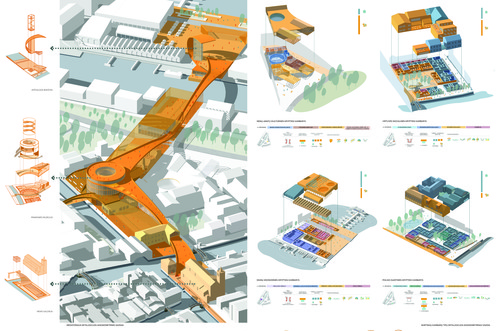Home
For international students
Vasiliauskaitė: "Mass tourism brings more harm than good to the city in the long run"
- Programmes in English 2025/2026
- Admission 2025/2026 Scholarships
- For exchange students
- Free Movers
- Transfer studies
- Erasmus+ studies and traineeships
- Mentor programme
- Student testimonials
- Accommodation
- Career Services
- Medical Care
- Immigration Regulations
- Leisure and Student Activities
- Useful information
- VILNIUS TECH for Creators of Tomorrow
- Mental and spiritual support
- Representatives Abroad
- Contacts
- Computer Engineering

2025-02-04
Vasiliauskaitė: "Mass tourism brings more harm than good to the city in the long run"
Some cities around the world are facing the challenge of providing a quality living environment for huge numbers of inhabitants, while others are struggling with the threat of extinction. The category of endangered cities includes not only small towns like in Lithuania, but also well-known, touristic cities around the world. Can mass tourism be a salvation for small towns, or on the contrary, a danger to all cities?
Greta Vasiliauskaitė, a graduate of the Faculty of Architecture at Vilnius Gediminas Technical University (VILNIUS TECH), has been studying the phenomenon of the city-museum in the case of Venice, and her thesis has been awarded as the best Master's Thesis in Arts for 2024 at the Lithuanian Young Scientists' Union competition.
"The biggest revelation for me was to understand how a city-museum can have two very different sides: on the one hand, it is a place where tourism stimulates the economy, and on the other hand, it can stifle the life and togetherness of the local community. The study showed that the main problem is not only the high number of tourists, but also the uneven use of the city's zones, with active sites being overcrowded and passive ones going almost unnoticed. This was the impetus for me to look for solutions to bring the less used areas of the city into life and to relieve the tension in the active spots," says Vasiliauskaitė about her research in Venice.
Assoc. prof. dr. Inesa Alistratovaitė-Kurtinaitienė, thesis supervisor, points out that the effect of mass tourism brought about by globalisation can either help a city develop or start destroying it: "The constant influx of visitors not only increases the cost of living, but also contributes to the deterioration of the historical centre's cultural and social fabric. This is particularly evident and relevant for historic cities - unique in terms of location, character, architecture, etc., such as Venice, Dubrovnik, Amsterdam, Barcelona, etc. In this context, Venice is a particularly exceptional city. Venetians are forced to move off the island when they are unable to find affordable housing, the services and spaces they need. This is leading to a rapid depopulation of the historic centre, which is on the verge of decay. The city centre is in danger of becoming a museum - a much-visited but dead artefact."
Vasiliauskaitė points out that tourism can, however, provide additional economic opportunities for small towns, as it can attract additional investment as the town's visibility and visitor numbers increase. However, she also notices that it is mass tourism that is unlikely to save such towns. "Excessive and sudden increases in visitor numbers can disrupt urban infrastructure, create social tensions and damage local identity. Mass tourism does more harm than good in the long run compared to slow and sustainable tourism. Sustainable tourism, which focuses on quality and smaller groups of tourists, can be more effective in promoting local culture and small businesses," says the Master of Architecture.
In addition to her studies, she took part in 6 architectural-urban design competitions and studied for a year in Venice (Università IUAV di Venezia) through the ERASMUS+ exchange programme. On her return, she proposed a thesis on cities-museums. She carried out an analysis of the promotion of urban vitality and drew up a matrix of practical tools, including universal approaches to improving the urban environment, which can be applied to different areas facing various challenges, such as environmental aesthetic and functional problems or the demographic and economic crisis.
"After assessing the area's problems, measures are selected from the five development axes proposed in the matrix: cultural, social, economic, communication and natural. The aim of these measures is to create an attractive environment for all users, especially local residents, so that they can live, work and play in an environment where they feel safe, comfortable and inspired to contribute to the growth of their city", says the urban designer. Vasiliauskaitė has put her research into practice and developed proposals to promote the vitality of Venice.
Since graduating from VILNIUS TECH, Greta has not only been awarded the best Master's thesis in the country, but she continues to work on issues that matter to cities around the world. Today, she is researching the housing crisis in the Netherlands - after her studies, she went to the Netherlands for an ERASMUS+ internship at an architecture and urban design firm, where she and her team analyse cities and their suburbs, looking for contextual urban solutions that can help revitalise and sustainably develop cities.
News photo: part of Master Thesis of Greta Vasiliauskaitė
Greta Vasiliauskaitė, a graduate of the Faculty of Architecture at Vilnius Gediminas Technical University (VILNIUS TECH), has been studying the phenomenon of the city-museum in the case of Venice, and her thesis has been awarded as the best Master's Thesis in Arts for 2024 at the Lithuanian Young Scientists' Union competition.
"The biggest revelation for me was to understand how a city-museum can have two very different sides: on the one hand, it is a place where tourism stimulates the economy, and on the other hand, it can stifle the life and togetherness of the local community. The study showed that the main problem is not only the high number of tourists, but also the uneven use of the city's zones, with active sites being overcrowded and passive ones going almost unnoticed. This was the impetus for me to look for solutions to bring the less used areas of the city into life and to relieve the tension in the active spots," says Vasiliauskaitė about her research in Venice.
Assoc. prof. dr. Inesa Alistratovaitė-Kurtinaitienė, thesis supervisor, points out that the effect of mass tourism brought about by globalisation can either help a city develop or start destroying it: "The constant influx of visitors not only increases the cost of living, but also contributes to the deterioration of the historical centre's cultural and social fabric. This is particularly evident and relevant for historic cities - unique in terms of location, character, architecture, etc., such as Venice, Dubrovnik, Amsterdam, Barcelona, etc. In this context, Venice is a particularly exceptional city. Venetians are forced to move off the island when they are unable to find affordable housing, the services and spaces they need. This is leading to a rapid depopulation of the historic centre, which is on the verge of decay. The city centre is in danger of becoming a museum - a much-visited but dead artefact."
Vasiliauskaitė points out that tourism can, however, provide additional economic opportunities for small towns, as it can attract additional investment as the town's visibility and visitor numbers increase. However, she also notices that it is mass tourism that is unlikely to save such towns. "Excessive and sudden increases in visitor numbers can disrupt urban infrastructure, create social tensions and damage local identity. Mass tourism does more harm than good in the long run compared to slow and sustainable tourism. Sustainable tourism, which focuses on quality and smaller groups of tourists, can be more effective in promoting local culture and small businesses," says the Master of Architecture.
In addition to her studies, she took part in 6 architectural-urban design competitions and studied for a year in Venice (Università IUAV di Venezia) through the ERASMUS+ exchange programme. On her return, she proposed a thesis on cities-museums. She carried out an analysis of the promotion of urban vitality and drew up a matrix of practical tools, including universal approaches to improving the urban environment, which can be applied to different areas facing various challenges, such as environmental aesthetic and functional problems or the demographic and economic crisis.
"After assessing the area's problems, measures are selected from the five development axes proposed in the matrix: cultural, social, economic, communication and natural. The aim of these measures is to create an attractive environment for all users, especially local residents, so that they can live, work and play in an environment where they feel safe, comfortable and inspired to contribute to the growth of their city", says the urban designer. Vasiliauskaitė has put her research into practice and developed proposals to promote the vitality of Venice.
Since graduating from VILNIUS TECH, Greta has not only been awarded the best Master's thesis in the country, but she continues to work on issues that matter to cities around the world. Today, she is researching the housing crisis in the Netherlands - after her studies, she went to the Netherlands for an ERASMUS+ internship at an architecture and urban design firm, where she and her team analyse cities and their suburbs, looking for contextual urban solutions that can help revitalise and sustainably develop cities.
News photo: part of Master Thesis of Greta Vasiliauskaitė
-
- Page administrators:
- Ugnė Daraškevičiūtė
- Monika Daukintytė














